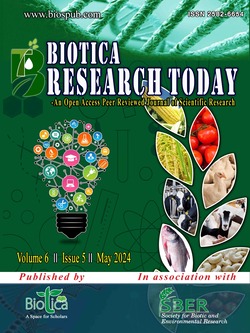
Exploring the Fish Viscera: Unveiling the Peptone Treasure Trove
Shivbhajan*
Dept. of Fish Processing Technology and Engineering, College of Fisheries, Central Agricultural University (Imphal), Lembucherra, Tripura (799 210), India
Bahni Dhar
Dept. of Fish Processing Technology and Engineering, College of Fisheries, Central Agricultural University (Imphal), Lembucherra, Tripura (799 210), India
Pritha Kumar
Dept. of Fish Processing Technology and Engineering, College of Fisheries, Central Agricultural University (Imphal), Lembucherra, Tripura (799 210), India
DOI: NIL
Keywords: Fish viscera, Fish waste, Microbial culture media, Peptone
Abstract
Seafood processing generates a significant amount of waste, including heads, viscera, skin, bones and scales. Improper management of this waste can lead to environmental and public health hazards. However, fish viscera contain valuable materials such as Peptones, sterols, protein hydrolysate, oil, enzymes and protein, which are essential for producing biodiesel and other oleochemicals. The protein from fish viscera is particularly beneficial for protein concentrates, hydrolysates, peptones and bioactive peptides, all of which play a crucial role in food processing and product development. Therefore, the recycling of fish waste is essential. Due to its high protein content, fish waste can be used as a raw material for microbiological media, potentially reducing production costs. Peptone, a vital component of bacteriological media, can be obtained from fish waste through acid hydrolysis, alkali hydrolysis and enzymatic hydrolysis.
Downloads
not found
Reference
Bhaskar, N., Benila, T., Radha, C., Lalitha, R.G., 2008. Optimization of enzymatic hydrolysis of visceral waste proteins of Catla (Catla catla) for preparing protein hydrolysate using a commercial protease. Bioresource Technology 99(2), 335-343. DOI: https://doi.org/10.1016/j.biortech.2006.12.015.
Esteban, M.B., García, A.J., Ramos, P., Márquez, M.C., 2007. Evaluation of fruit-vegetable and fish wastes as alternative feedstuffs in pig diets. Waste Management 27(2), 193-200. DOI: https://doi.org/10.1016/j.wasman.2006.01.004.
Gildberg, A., Dahl, R., Mikkelsen, H., Nilsen, K., 2010. Peptones from Atlantic cod stomach as nitrogen sources in growth media to marine bacteria. Journal of Aquatic Food Product Technology 19(2), 75-83. DOI: https://doi.org/10.1080/10498850.2010.486523.
Jayathilakan, K., Sultana, K., Radhakrishna, K., Bawa, A.S., 2012. Utilization of byproducts and waste materials from meat, poultry and fish processing industries: A review. Journal of Food Science and Technology 49, 278-293. DOI: https://doi.org/10.1007/s13197-011-0290-7.
Vidotti, R.M., Viegas, E.M.M., Carneiro, D.J., 2003. Amino acid composition of processed fish silage using different raw materials. Animal Feed Science and Technology 105(1-4), 199-204. DOI: https://doi.org/10.1016/S0377-8401(03)00056-7.
